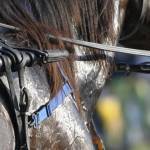Genetic Mutation Found in Anhidrotic Horses

Horses incapable of sweating normally, a condition known as anhidrosis, are at risk of developing hyperthermia if exercised too rigorously or unable to seek shelter in hot, humid conditions. While long believed to have a heritable component, only recently have researchers identified a genetic mutation that may be responsible for chronic idiopathic anhidrosis (CIA).*
Sweat glands are found extensively throughout the skin of horses in close association with hair follicles. In response to exercise, when body temperature begins to rise, sweat glands secrete large volumes of water, protein, and electrolytes.
“The core electrolytes responsible for fluid balance in the body are sodium, chloride, and potassium, which are normally present in large amounts in sweat. For horses that sweat normally, these electrolytes must be replenished after exercise. One common therapeutic approach is oral electrolyte supplementation with a proven product like Restore,” explained Kathleen Crandell, Ph.D., a nutritionist for Kentucky Equine Research.
Sweat evaporation from the skin is the main mechanism by which horses maintain a stable body temperature, or thermoregulate, accounting for up to 65% of heat loss. When anhidrotic horses do not sweat sufficiently, their core body temperature rises, putting them at risk of heat stroke. In addition to increased body temperature, signs of hyperthermia include labored breathing, flared nostrils, increased heart rate, fatigue, and possibly collapse.
Due to the strong suspicion of a hereditary component to CIA, geneticists collected DNA samples from both healthy anhidrotic and non-anhidrotic horses. Horses thought to have CIA based on owner- or veterinary-provided history were identified through a survey distributed by the research team. In total, 200 horses were included in the study (100 anhidrotic and 100 controls), all of which were Thoroughbreds or stock-type horses, including Quarter Horses, Paints, and Appaloosas.
Common signs associated with CIA in the surveyed horses included lack of sweating in the hindquarters, neck, and under the saddle, increased heart rates and body temperature (greater than 104° F), shortness of breath or increased respiratory rates, and lethargy.
The DNA of all horses was analyzed using genome-wide association studies. A region of the gene KCNE4 was identified in the CIA horses that had a different coding sequence than the same gene in healthy control horses.
This KCNE4 gene produces the KCNE4 protein, which is a potassium channel β subunit protein. This subunit is thought to interact with another protein, a KCNQ1 channel, believed to play a role in potassium ion excretion in sweat production.
“Thus, the genetic mutation found in the KCNE4 gene resulting in a structural change in the KCNE4 protein could alter potassium secretion during sweat production,” summarized Crandell.
While the exact details regarding the role of the KCNE4 mutation in CIA remain to be uncovered, this research opens the door to further research in an area that has, until now, been largely unexplored.
“Once genetic mutations or additional mechanisms explaining this condition are identified, veterinarians may be able to develop targeted treatment options,” Crandell said.
*Patterson Rosa, L., N. Walker, M. Mallicote, R.J. Mackay, and S.A. Brooks. 2021. Genomic association of chronic idiopathic anhidrosis to a potassium channel subunit in a large animal model. Journal of Investigative Dermatology 141(11):2639-2645.e3.








